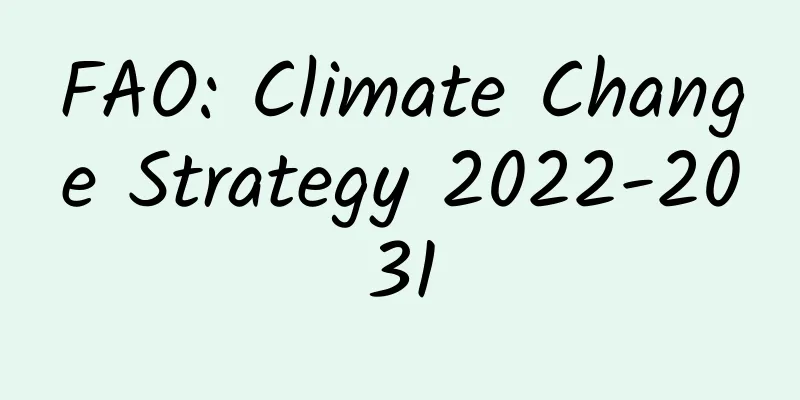FAO: Climate Change Strategy 2022-2031

|
The Climate Change Strategy, approved by the FAO Council in June 2022 , aims to promote a more adaptive and resilient low-carbon economy, drive public awareness and adoption of relevant solutions and attract investment; " while at the same time providing sufficient, safe and nutritious food for healthy diets and other agricultural products and services for the benefit of present and future generations, leaving no one behind . " Most importantly, the Climate Change Strategy emphasizes that " we must act now " . In order to successfully and timely implement the strategy, FAO has consulted with its member countries and developed an action plan based on this to best reflect the needs and priorities of member countries. The implementation cycle of the action plan is 2022-2025 , during which a mid-term review of implementation will be conducted. Agri-food systems and climate change are closely linked The global agricultural food system includes the production of food and non-food agricultural products, as well as their storage, transportation, processing, distribution, marketing, disposal and consumption. From a climate perspective, the agricultural food system currently accounts for about one-third of global greenhouse gas emissions, but is also the main victim of the climate crisis. Agri-food systems can provide multiple solutions to the climate crisis, including building resilience and adaptive capacity, mitigating global warming and sequestering greenhouse gases. " FAO's Climate Change Strategy is our response to the global challenge of addressing the impacts of the climate crisis," said FAO Director-General QU Dongyu. "The Strategy seeks to address a wide range of interconnected challenges, including biodiversity loss, desertification, land and environmental degradation, the need for accessible and affordable renewable energy, and food and water security. The Action Plan will help FAO to coordinate its actions and integrate solutions for climate change in agri-food systems across all areas of its work. " Three pillars of action The Action Plan sets out a series of specific outputs corresponding to the outcomes and three pillars identified in the Climate Change Strategy, including strengthening communication and advocacy at the global and regional levels, providing policy support at the national level, and scaling up climate action with various actors and vulnerable groups at the local level. In terms of the first pillar, FAO has already stepped up its advocacy efforts in various global forums. For example, as a strategic partner for the Presidency of the 27th United Nations Climate Change Conference in Sharm el-Sheikh in November 2022, FAO supported the inclusion of agriculture in the agenda of climate negotiations and opened the Food and Agriculture Pavilion during the Climate Change Conference for the first time. FAO will maintain its advocacy efforts during the United Arab Emirates' Presidency of the Climate Change Conference. In terms of policy support to FAO Member States, the Action Plan will continue to support Member States in developing and implementing their climate commitments, especially National Adaptation Plans and Nationally Determined Contributions. FAO is very active in this area and is currently supporting 12 countries in Africa, Asia and Latin America to expand climate objectives in land use and agriculture through Nationally Determined Contributions and National Adaptation Plans. For example, Nepal is committed to building a more resilient agricultural system and strengthening the sustainability of agriculture and land use, but its government institutions have weak capacity to deal with climate change-related issues. To this end, FAO provides Nepal with professional technical expertise and other valuable support to help Nepal achieve its national goals. The third pillar aims to promote the active engagement of stakeholders at the local level, especially vulnerable groups such as women and indigenous peoples, to identify, co-develop and scale up good practices to address climate change, biodiversity loss and land degradation while enhancing food security and improving livelihoods. |
<<: Nokia N9 is not dead: it can boot up three operating systems
>>: Sex robots: Love me or them?
Recommend
Amazon Athena is now available in AWS China (Ningxia) Region
The new pay-as-you-go interactive query service c...
Are casual games on the sidelines? Breakout 2 is leading video games into the era of blockbusters
Screen: Sound Effects: operate: Plot: Experience:...
Bidding price adjustment ideas, Baidu bidding price adjustment strategies and analysis!
When we are doing bidding promotion, we must make...
Strawberries are the "dirtiest fruit"? Why do experts recommend eating them? The truth is...
This article was reviewed by Pa Li Ze, chief phys...
Why is the conversion effect of your copy always limited?
What is the most important feature of a copy that...
WeChat responds to reading user photo albums: This function will no longer be used
Earlier today, some netizens revealed that WeChat...
How to acquire the first 1,000 high-quality seed users at low cost within one month?
You have no money, no resources, and you feel ove...
CTO Training Camp Guo Jiangliang: Big Data Platform in Baidu Private Cloud and Open Cloud
Guo Jiangliang, R&D manager of Baidu Open Clo...
You must be kidding! How can dolphins run to the Mekong River? Aren’t they in the sea?
In the southeast of China's Qinghai-Tibet Pla...
The iPhone SE is aimed at users who have never used a smartphone.
Yesterday, Apple released the iPhone SE at its pr...
SEM Promotion | How to solve these problems encountered in bidding?
Q1. Why can’t OCPC grab some keywords more than o...
Can your cell phone "eavesdrop" on you? Research shows that your cell phone may be "eavesdropped" on you!
I just finished talking to a friend about somethi...
After this wave of updates, WeChat can finally upload complete original videos?
WeChat has recently launched a wave of incrementa...
Nanping SEO training: The website articles have been updated but not received
If the content of the article is in this situatio...
If you don’t know how to plan a marketing campaign, just read this article!
When planning a marketing campaign , do you alway...









